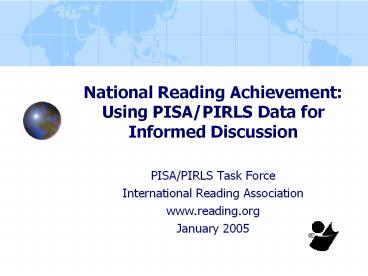National Reading Achievement: Using PISA/PIRLS Data for Informed Discussion PowerPoint PPT Presentation
1 / 13
Title: National Reading Achievement: Using PISA/PIRLS Data for Informed Discussion
1
National Reading Achievement Using PISA/PIRLS
Data for Informed Discussion
- PISA/PIRLS Task Force
- International Reading Association
- www.reading.org
- January 2005
2
Discussing National Reading Achievement Using
PISA/PIRLS Data
- This PowerPoint is the work of the International
Reading Associations PISA/PIRLS Taskforce - Renate Valtin (chair), Humboldt University of
Berlin, Germany - William Brozo, George Mason University, United
States - M. Lourdes Dionisio, University of Minho,
Portugal - Keith Topping, University of Dundee, Scotland
- James Flood and Ann-Sofie Selin serve as
liaisons from the Board of Directors. Cathy
Roller, Director of Research and Policy, is
International Reading Association staff liaison.
3
Discussing National Reading Achievement Using
PISA/PIRLS Data
- Under Board direction, the PISA/PIRLS Taskforce
- Examined the Programme for International
Student Assessment (PISA) and the Progress in
International Reading Literacy Study (PIRLS)
results. - Consulted with national representatives from 23
nations in Linköping, Sweden, June 10, 2004, with
support from International Reading Associations
International Development Committee in Europe
(IDEC) and Linköping University. The meeting
agenda and a list of participants is available. - Prepared this PowerPoint professional
development guide that councils and affiliates
can use when analyzing national reading
instruction and achievement using PISA/PIRLS data.
4
Discussing National Reading Achievement Using
PISA/PIRLS Data
- PISA (2000) and PIRLS (2001) provide
- Reading literacy achievement data at key
developmental milestones - Comparative information about reading
achievement across the participating nations . - Series of reports that include graphs, tables,
figures and text that compare scores and produce
rankings among the countries. See PISA 2000
reports. See PIRLS 2001 report.
5
Discussing National Reading Achievement Using
PISA/PIRLS Data
- PISA and PIRLS data
- Are correlational and represent cross-sectional
studies - Represent averages and vary somewhat by
individual country - Do not identify causal relationships
- Can identify important factors and raise
significant questions, but cannot definitively
identify remedies - Gain value when context of country, culture, and
demographic and background variables are used in
analyses to inform policymaking
6
PIRLS Definition of Literacy
- the ability to understand and use those written
language forms required by society and/or valued
by the individual. Young readers can construct
meaning from a variety of texts. They read to
learn, to participate in communities of readers
in school and everyday life, and for enjoyment".
7
PIRLS - Methods
- One-hour, paper-and-pencil literacy test assesses
range of reading comprehension strategies for
literary informational reading purposes among
9-year-old students in 35 participating countries
- Student questionnaire - individual, home,
school factors - Parent questionnaire support literary
resources - Teacher questionnaire individual factors,
instruction materials - School principal questionnaire - organization of
teaching learning
8
PISA Definition of Literacy
"the ability to understand, reflect on and use
written texts, in order to achieve one's goals
and participate effectively in society"
9
PISA - Methods
- Two-hour, paper-and-pencil literacy test assesses
abilities to use literacy knowledge among
15-year-old students from 32 participating
countries - Student questionnaire - individual, home,
school factors - School principal questionnaire - organization of
teaching learning
10
Discussing National Reading Achievement Using
PISA/PIRLS Data
PISA and PIRLS data are not intended to point
policymakers to simple solutions, such as trying
to improve reading literacy scores by looking at
high-ranking countries and doing what they do.
Instead, policymakers can use the broader
context provided by international studies to
examine in depth policies and practices that
contribute or limit opportunities for student
achievement.
11
Discussing National Reading Achievement Using
PISA/PIRLS Data
National analyses using PISA/PIRLS data allow
test score comparisons within a context linked to
country-specific demographic and background
variables. National reading literacy
achievement can be improved when action plans
reflect the conjunction of PISA/PIRL findings and
country context.
12
Discussing National Reading Achievement Using
PISA/PIRLS Data
Specific Topics addressed by PISA/PIRLS
- Assessments
- School structure
- School management
- Resources
- Teacher education
- Professional development
- Gender
- Socioeconomic status (SES)
- Home and community
- Engagement
- Underachievement
13
Discussing National Reading Achievement Using
PISA/PIRLS Data
Discussion Guides PISA/PIRLS created a rich body
of information about factors affecting reading
achievement. The broad topic areas listed below
present findings and provide context questions
that can direct the development of an action
plan. Councils and affiliates can examine all
areas or select among the topics and subtopics
presented. Topics Classroom Factors Assessment,
curriculum instruction, Resources School
Factors Homeschool transition, management
leadership, structure resources Individual,
Home Community Factors Home environment,
socioeconomic status occupation, individual
characteristics

